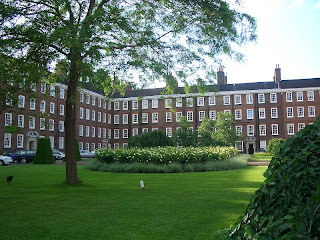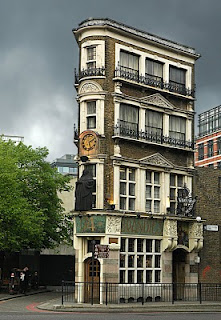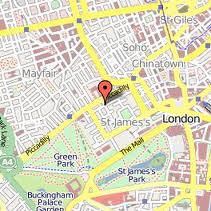Victoria, here, dreaming about my weeks in England last spring. Here are my photos of Coutts Bank, The Strand, London, taken in June 2011. The bank’s website is here.
It looks like an important place, though the architecture is about as 1970’s Mundane as one could imagine. The only reason I actually noticed it was that I was often across the street, sitting in McDonald’s where I could use their free wi-fi to power my iPad.* I was particularly amused that this great London institution, the bank that holds accounts for Her Majesty the Queen, had a glass curtain wall that clearly reflected that notable American institution on the other side!
[*Why is is that really inexpensive hotels have free wi-fi service while the better establishments charge outrageous amounts for the same thing? ]
As I walked closer to get this picture of the reflection of McDonald’s, I think that guard inside picked up the phone to call for assistance to deal with the clearly deranged photographer on the pavement! I didn’t wait around to see what happened! I’ll bet the bank’s directors did not consider what might happen to the glass during major demonstrations moving towards the adjacent Trafalgar Square. You can clearly see the McDonald’s sign reflected above and to the right of his head.
So, fully knowing I was edging into Wellington Connection territory, I decided to see what more I could learn about Coutts Bank. Angela Coutts (1814-1906) was a dear friend of the 1st Duke of Wellington, one of those younger women so attracted to the Great Hero (*like many of us???). But there must be much more. The bank’s website has a nice timeline and lots of information, but other than the widely known fact that QEII banks there, the list of clients is a well-protected secret.
It is said that checks written by (for?) the Queen are often saved as souvenirs, making it difficult to balance her accounts.
Here is an account of a famous period in the existence of the bank, excerpted from Tales of the Bank of England, with anecdotes of London bankers, an anonymous book from 1882:
“The house of Coutts & Co. has a very interesting history. A very great banking heiress is the Baroness Burdett-Coutts, whose recent marriage with Mr. Ashmead Coutts-Bartlett excited so much attention. The kindly and popular Baroness is—or was until recently—the head of the great banking firm of Coutts & Co., and was popularly supposed to draw a hundred thousand a year from the business. Mr. Coutts married, for his second wife, Miss Mellon, the actress, to whom he left his entire fortune—about a million of money. Mrs. Coutts, left a widow, married the Duke of St. Albans; but, in her marriage settlement, this vast fortune was left entirely in her own power. She thought that she would best carry out the wishes of her husband, who had made the money, by bequeathing it to his favourite granddaughter, Miss Angela Burdett, the daughter of the famous Sir Francis. An infinite amount of this money “has wandered Heaven-directed, to the poor.” Child’s Bank was once represented by a lady, who became Countess of Westmoreland, and afterwards by her daughter, who became Countess of Jersey. On certain state occasions Lady Jersey dined with the bank officials, and took the head of the table.
The history of Coutt’s Bank shows how much may be done by a discriminating liberality. Old Coutts heard, one day at a dinner-party, from the manager of a city bank, that a nobleman had applied to his house for the loan of thirty thousand pounds, and had been refused. At ten o’clock at night he started for the peer’s house, and saw his steward. He explained his business, and said that if the nobleman would call upon him the next morning, he might have whatever he wanted. On the next morning, when the noble lord called at the bank, Mr. Coutts handed him thirty notes of a thousand pounds each. “What security do you want?” asked the peer. “I shall be satisfied with your note-of hand,” was the reply. This was given; and the nobleman said, ” I shall only want for the present ten thousand pounds of the money; so I will leave twenty thousand pounds with you, and open an account.” Some time afterwards the nobleman sold an estate for two hundred thousand pounds, which he deposited with Coutts’s. Nor was this all. He told the anecdote to his friends, and also to George III. The King was so impressed with the story that he himself deposited a large sum with Mr. Coutts. The King withdrew his patronage, however, when Coutts supported Sir Francis Burdett in his contest for Middlesex with immense sums, and transferred his account to another banker, who failed; and we cannot help thinking that in this instance his Majesty was served quite right.”

Angela Burdett-Coutts, portrait by an unknown artist, from the National Portra
it Gallery
Another old excerpt about the bank appears in Walter Thornbury’s 1865 volume Haunted London (this obviously refers to the old headquarters of the bank on The Strand, not the present building pictured above):
“No. 59 is Coutts’s Bank. It was built by the Adam brothers—to whom we are indebted for the Adelphi—for Mr. Coutts, in 1768. The old house of the firm, of the date of Queen Anne, was situated in St. Martin’s-lane. No. 59 contains some fine marble chimney-pieces of the Cipriani and Bacon school. The dining-room is hung with quaint Chinese subjects on paper, sent to Coutts by Lord Macartney, while on his embassy to China, in 1792-95. In another room hang portraits of some early friends of this son of Mammon, including Dr. Armstrong, the poet and physician, Fuseli’s friend, by Reynolds. Mr. Coutts was the son of a Dundee merchant. His first wife was a servant, a Lancashire labourer’s offspring. He had three daughters, one of whom became the wife of Sir Francis Burdett, a second Countess of Guilford, and a third Marchioness of Bute. On becoming acquainted with Miss Mellon, and inducing her to leave the stage to avoid perpetual insults, Mr. Coutts bought for her a small villa of Sir W. Vane Tempest, called Holly Lodge, at the foot of Highgate Hill, for which he gave 25,000/. His banking-house strong rooms alone cost 10,000/. building. The first deposit in the enlarged house was the diamond aigrette that the Grand Signor had placed in Sir Horatio Nelson’s hat. Mr. Coutts, though very charitable, was precise and exact. On one occasion, there being a deficit of 2s. li)d. in the day’s accounts, the clerks were detained for hours, or, as I believe, all night. One of Coutts’s clerks, who took the western walk, was discovered to be missing with 17,000/.* Rewards were offered, and the town placarded, but all in vain. The next day, however, the note-case arrived from Southampton. The clerk’s story was, that on his way through Piccadilly, being seized with a stupor, he had got into a coach in order to secure the money. He had remained insensible the whole journey, and had awoke at Southampton. Mr. Coutts gave him a handsome sum from his private purse, but dismissed him.
Coutts’s Bank stands on nearly the centre of the site of the New Exchange. When the Adelphi was built in Durham Gardens, Mr. Coutts purchased a vista to prevent his view being interrupted, stipulating that the new street leading to the entrance should face this opening; and on this space, up to the level of the Strand, he built his strong rooms. Some years after, wishing to enlarge them, he erected over the office a counting-house and set of offices, extending from William-street to Robert-street, and threw a stone bridge over William-street to connect the front and back premises.
Mr. Coutts, a few years before his death, married Harriet Mellon, who, after his death, became the wife of the Duke of St. Albans, a descendant of Nell Gwynn, that light-hearted wanton, whom nobody could hate. “Miss Mellon,” says Leigh Hunt, “was arch and agreeable on the stage; she had no genius; but then she had fine eyes and a goodhumoured mouth.” The same gay writer describes her when young as bustling about at sea-ports, selling tickets for her benefit-night; but then, says the kindly apologist for everybody, she had been left with a mother to support.”
I wish that old building was still the headquarters. And I suspect that you will hear more about Angela Burdett-Coutts in this space in the future.
In 1969 Coutt’s Bank, with origins in the late 17th century, was bought by National Westminster Bank (NatWest), and in 2000, NatWest was purchased by the Royal Bank of Scotland. Coutt’s is now the wealth division of the conglomerate, engaged in private banking, with branches and offices worldwide. To become their client, I assume you would have to rob your piggy bank. And a few others as well.
 |
| The Strand, c. 1824 |



















